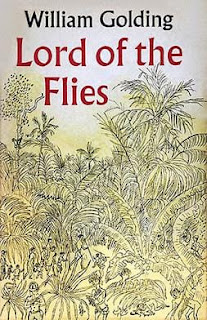"LORD OF THE FLIES"
by William Golding (summery)
by William Golding (summery)
"Lord of the Flies" is a novel written by British author William Golding. It was first published in 1954 and is a classic work of literature.
I first read this book when I was in my teens, during the mid 1960's. Although the first film adaptation was released in 1963, it was way into the 1970's before our local cinema premiered it. I remember having to queue for what seamed like forever, but then again it was well worth the wait. A very harrowing film indeed.
Here's a summary and critical analysis of "Lord of the Flies":
**Summary:**
"Lord of the Flies" by William Golding is a novel about a group of British boys, including Ralph, Piggy, Jack, and others, who find themselves stranded on a deserted island due to a plane crash during a war. At first, they attempt to establish order and create a system of governance, electing Ralph as their leader. They use a conch shell as a symbol of authority, and they attempt to maintain a signal fire to attract rescuers.
However, as time passes, the boys' society begins to unravel. The group splits into two factions: one led by Ralph, who seeks to maintain a sense of civilization and hope for rescue, and the other led by Jack, who becomes increasingly savage and power-hungry. Jack's group embraces violence and worships a pig's head on a stick as "The Lord of the Flies," representing the primal and dark instincts within them.
As the boys descend into barbarism, their fear of a mythical beast on the island and their internal conflicts lead to violence and death. In the end, a naval officer arrives, rescuing the boys but highlighting the chaos and brutality that have taken hold on the island.
**Critical Analysis:**
"Lord of the Flies" is a deeply allegorical and thought-provoking work that explores the inherent human capacity for evil and the fragility of civilization. Here are some key aspects of its critical analysis:
1. **Allegory of Human Nature:** The novel serves as an allegory for the darker aspects of human nature. It suggests that, when removed from the constraints of society, individuals are capable of cruelty and brutality. The characters of Jack and Roger represent the descent into savagery, contrasting with Ralph's desire for civilization and order.
2. **Symbolism:** Golding uses powerful symbols throughout the novel. The conch shell symbolizes order and democracy, while the "Lord of the Flies" symbolizes the inner evil that resides within us all. The island itself represents a microcosm of the larger world.
3. **Loss of Innocence:** The story traces the loss of the boys' innocence as they move from well-behaved schoolboys to violent and destructive individuals. The killing of Piggy and Simon, in particular, symbolizes the ultimate loss of their innocence.
4. **Social Commentary:** Golding provides a commentary on the brutality of war and the capacity for violence that exists within society. The novel explores how human beings can slip into chaos and cruelty when isolated from the structures of civilization.
5. **Narrative Style:** Golding's writing is characterized by its vivid and haunting descriptions. The novel's intense and atmospheric prose draws the reader into the boys' descent into savagery.
Overall, "Lord of the Flies" is a powerful and disturbing exploration of the human condition and remains a classic in literature for its examination of the dark side of humanity and the fragility of civilization.
Brought to you by https://thecorner4women.com together with our sister website http://www.nicheebookcollections.com and our growing e-book library available FREE, through our Newsletter sign up page here:-





No comments:
Post a Comment